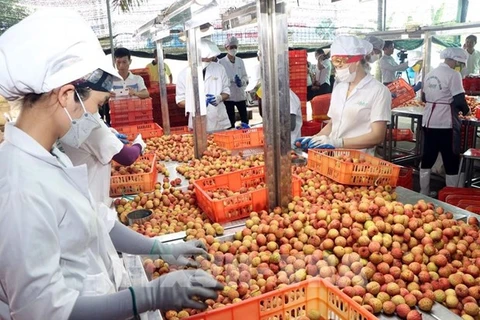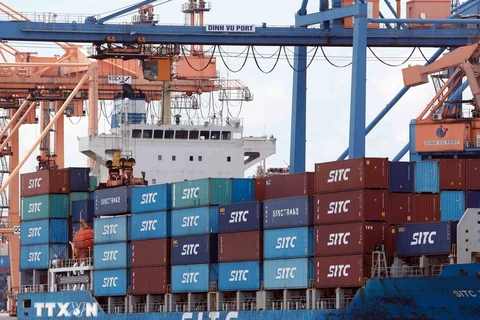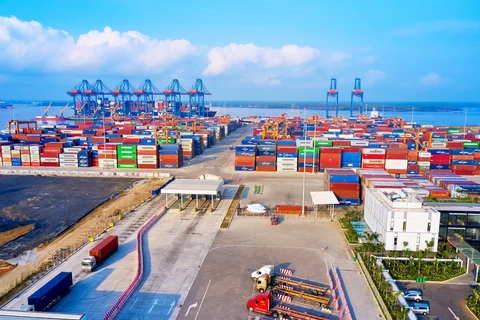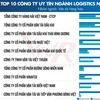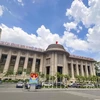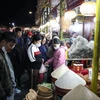HCM City (VNA) – Experts gathered at a forum in Ho Chi Minh City on April 25 to seek ways to untangle knots in terms of capital and market for exporters in the context that the ongoing conflicts in many regions are disrupting international trade.
Truong Dinh Hoe, General Secretary of the Vietnam Association of Seafood Exporters and Producers (VASEP), said the country saw increases in orders in the first quarter of this year, notably aquatic product exports rose nearly 7% year-on-year to nearly 2 billion USD.
In terms of market, many businesses were hesitant to export to the European Union (EU) due to the conflicts, while shipments to the US, China and Japan grew significantly, he said.
Hoe noted that although Vietnam has self-supplied more than 70% of aquaculture materials, the hikes in the prices of aquatic feed and packaging materials, and transport costs have affected domestic production and business.
Garment-textile exports also rebounded in the first months of 2024, reaching some 9.5 billion USD, up 9.6% year-on-year, earning the country the third position in the global market, only after China and Bangladesh, according to Tran Nhu Tung, Vice President of the Vietnam Textile and Apparel Association (VITAS).
Tung, however, pointed to rising production costs and higher requirements by clients as double pressures on domestic exporters although their orders are piling up.
Chairman of GC Food JSC Nguyen Van Thu said the company’s customers in the Middle East have suspended their orders due to transport and payment challenges, and declining demand.
Meanwhile, GC Food is facing exchange rate problems in its main markets, comprising the Republic of Korea, Japan and China, he added.
Although the world's demand is recovering thanks to low inventories of many products, experts advised businesses to be ready for conflict-induced lingering supply chain and transport issues.
Head of the Vietnam Trade Office in Saudi Arabia Tran Trong Kim said the Red Sea unrest has caused declines in orders, and affected trade between Vietnam and Saudi Arabia.
He suggested agencies and organisations at home further provide updates for associations and businesses to make preparedness for difficulties in Saudi Arabia and Yemen in the time ahead, saying Vietnamese firms should be cautious in trading with partners in conflict-hit regions.
The Ministry of Industry and Trade also advised enterprises to diversify goods supplies and export markets, and stay updated with market developments./.
Truong Dinh Hoe, General Secretary of the Vietnam Association of Seafood Exporters and Producers (VASEP), said the country saw increases in orders in the first quarter of this year, notably aquatic product exports rose nearly 7% year-on-year to nearly 2 billion USD.
In terms of market, many businesses were hesitant to export to the European Union (EU) due to the conflicts, while shipments to the US, China and Japan grew significantly, he said.
Hoe noted that although Vietnam has self-supplied more than 70% of aquaculture materials, the hikes in the prices of aquatic feed and packaging materials, and transport costs have affected domestic production and business.
Garment-textile exports also rebounded in the first months of 2024, reaching some 9.5 billion USD, up 9.6% year-on-year, earning the country the third position in the global market, only after China and Bangladesh, according to Tran Nhu Tung, Vice President of the Vietnam Textile and Apparel Association (VITAS).
Tung, however, pointed to rising production costs and higher requirements by clients as double pressures on domestic exporters although their orders are piling up.
Chairman of GC Food JSC Nguyen Van Thu said the company’s customers in the Middle East have suspended their orders due to transport and payment challenges, and declining demand.
Meanwhile, GC Food is facing exchange rate problems in its main markets, comprising the Republic of Korea, Japan and China, he added.
Although the world's demand is recovering thanks to low inventories of many products, experts advised businesses to be ready for conflict-induced lingering supply chain and transport issues.
Head of the Vietnam Trade Office in Saudi Arabia Tran Trong Kim said the Red Sea unrest has caused declines in orders, and affected trade between Vietnam and Saudi Arabia.
He suggested agencies and organisations at home further provide updates for associations and businesses to make preparedness for difficulties in Saudi Arabia and Yemen in the time ahead, saying Vietnamese firms should be cautious in trading with partners in conflict-hit regions.
The Ministry of Industry and Trade also advised enterprises to diversify goods supplies and export markets, and stay updated with market developments./.
VNA

